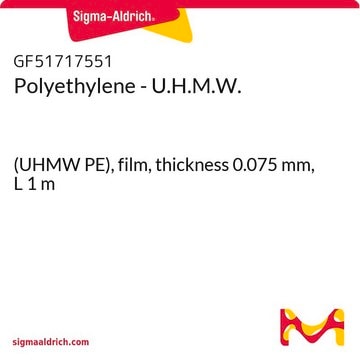GF70298253
Zinc
foil, 4mm disks, thickness 0.01mm, 99.9%
Synonym(s):
Zinc, ZN000160
Sign Into View Organizational & Contract Pricing
All Photos(2)
About This Item
Empirical Formula (Hill Notation):
Zn
CAS Number:
Molecular Weight:
65.39
MDL number:
UNSPSC Code:
12141750
PubChem Substance ID:
NACRES:
NA.23
Recommended Products
vapor pressure
1 mmHg ( 487 °C)
Assay
99.9%
form
foil
manufacturer/tradename
Goodfellow 702-982-53
resistivity
5.8 μΩ-cm, 20°C
diam. × thickness
4 mm × 0.01 mm
bp
907 °C (lit.)
mp
420 °C (lit.)
density
7.133 g/mL at 25 °C (lit.)
SMILES string
[Zn]
InChI
1S/Zn
InChI key
HCHKCACWOHOZIP-UHFFFAOYSA-N
General description
For updated SDS information please visit www.goodfellow.com.
Legal Information
Product of Goodfellow
Certificates of Analysis (COA)
Search for Certificates of Analysis (COA) by entering the products Lot/Batch Number. Lot and Batch Numbers can be found on a product’s label following the words ‘Lot’ or ‘Batch’.
Already Own This Product?
Find documentation for the products that you have recently purchased in the Document Library.
Yang Liu et al.
Chemistry (Weinheim an der Bergstrasse, Germany), 13(23), 6667-6673 (2007-05-31)
Well-aligned zinc oxide microrod and microtube arrays with high aspect ratios were fabricated on zinc foil by a simple solution-phase approach in an aqueous solution of ethylenediamine (en). The shape of the ZnO microstructures can be easily modulated from rods
Zhengquan Li et al.
Chemistry (Weinheim an der Bergstrasse, Germany), 10(22), 5823-5828 (2004-10-09)
A solution surface-erosion route was successfully employed to produce one-dimensional (1D) ZnO nanostructures. ZnO nanorod arrays and three-dimensional urchin-like assemblies could be selectively obtained with different manipulations. In this process, zinc foil was introduced to an organic solution system and
Pritesh Hiralal et al.
ACS nano, 4(5), 2730-2734 (2010-04-27)
Solid-state and flexible zinc carbon (or Leclanche) batteries are fabricated using a combination of functional nanostructured materials for optimum performance. Flexible carbon nanofiber mats obtained by electrospinning are used as a current collector and cathode support for the batteries. The
Ronny Lehneck et al.
The FEBS journal, 281(7), 1759-1772 (2014-02-11)
Carbonic anhydrases (CAs) are metalloenzymes catalyzing the reversible hydration of carbon dioxide to bicarbonate (hydrogen carbonate) and protons. CAs have been identified in archaea, bacteria and eukaryotes and can be classified into five groups (α, β, γ, δ, ζ) that
Chenglin Yan et al.
The journal of physical chemistry. B, 110(51), 25850-25855 (2006-12-22)
Vertically aligned ZnO nanorods with uniform diameter and length have been synthesized on a zinc foil substrate with ammonium persulfate as oxidant via a facile, larger scale production and inexpensively synthesized method without any templates or additives. SEM and XRD
Our team of scientists has experience in all areas of research including Life Science, Material Science, Chemical Synthesis, Chromatography, Analytical and many others.
Contact Technical Service


